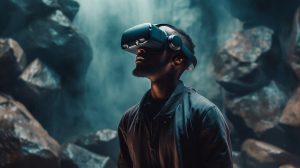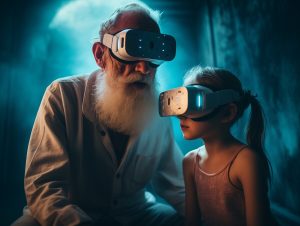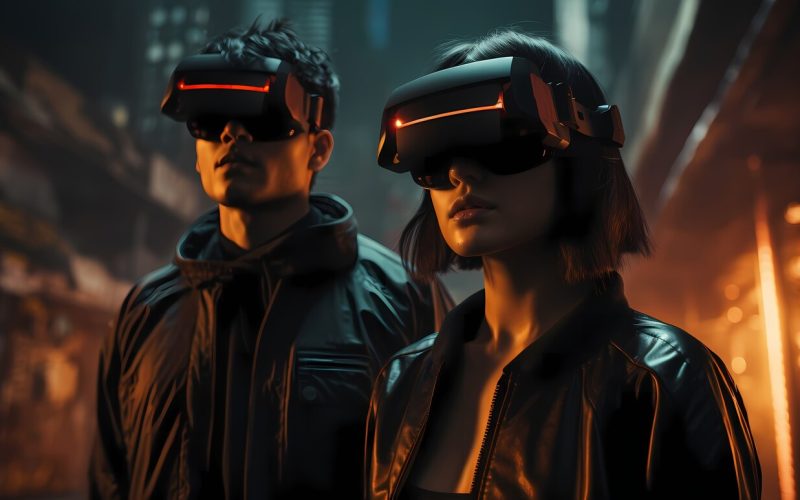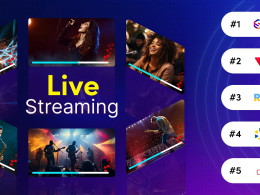Introduction
In recent years, Virtual Reality (VR) and Augmented Reality (AR) have revolutionized various industries, with the film industry being one of the most significantly impacted. These technologies have introduced immersive experiences, changed how filmmakers tell stories, and altered audience engagement. As VR and AR continue to evolve, their influence on the film industry is becoming more profound. In this article, we explore VR/AR film industry technologies are shaping the future of filmmaking, from production techniques to viewer experiences.
VR and AR in Filmmaking
Virtual Reality (VR) allows users to be fully immersed in a computer-generated environment, where they can interact with the surroundings as though they were real. Augmented Reality (AR), on the other hand, enhances the real world by overlaying digital elements onto physical environments. Both technologies have made significant contributions to filmmaking by offering filmmakers new tools to create more immersive and interactive storytelling.
VR and AR are not just fleeting trends. They represent a significant shift in how movies are produced, experienced, and consumed. By integrating these technologies, the film industry is moving toward more immersive experiences that engage the audience beyond traditional two-dimensional screens.
The Evolution of Storytelling

Impact on Film Production

VR and AR are transforming the film production process. In pre-production, VR allows filmmakers to visualize scenes before they are shot. Directors can walk through a virtual set, adjust the placement of cameras, and experiment with lighting before any physical work begins. This reduces costs by identifying potential problems early on and allows for more creativity without the constraints of physical space.
In post-production, AR is being used for digital augmentation, enabling filmmakers to add realistic special effects. Characters, objects, and backgrounds can be enhanced or even entirely created using AR. This is particularly useful in genres like science fiction and fantasy, where creating elaborate sets and creatures can be costly. AR allows filmmakers to achieve a high level of detail while maintaining a budget-friendly production.
Augmented Reality Adds Extra Layers
AR adds excitement to movies by showing more information. While watching a movie, you could use your phone or tablet to see extra content, like fun facts about the characters or hidden scenes. This kind of interaction gives filmmakers a way to add more details to the story without interrupting the movie. It helps viewers feel more involved in what’s happening on the screen.
Enhancing Audience Experience
One of the most exciting aspects of VR and AR in the film industry is how they change the way audiences experience movies. Traditional films follow a linear narrative, where viewers passively watch a story unfold. However, with VR, audiences can become part of the story. They can look around a 360-degree environment and interact with elements of the narrative. This level of immersion adds depth to the story and allows viewers to feel like active participants, rather than passive observers.
AR enhances the viewing experience by integrating digital elements into the physical environment. For example, a viewer watching a movie on their mobile device could see additional content, such as character backgrounds or interactive maps, overlaid onto the screen. This not only makes the viewing experience more engaging but also offers new ways for filmmakers to tell complex stories.
Case Studies: VR and AR in Action

Several major film projects have already experimented with VR and AR technologies, pushing the boundaries of traditional filmmaking. For instance, “The Lion King” (2019) used VR to allow directors to step into the virtual set, visualizing scenes in a completely digital environment. This not only streamlined production but also allowed for a more realistic and immersive final product.
Similarly, the film “Ready Player One” (2018) heavily featured AR and VR both within the storyline and in its production. Audiences were given VR experiences that allowed them to explore the virtual world of the movie, creating a bridge between the film and real-life interaction.
These films show that VR and AR can enhance both the production process and audience engagement, setting the stage for more filmmakers to adopt these technologies.
Reaching New Audiences
As VR and AR become more popular, filmmakers are finding new ways to reach more people. These tools make movies more exciting, especially for younger audiences who are used to interactive video games. Although not everyone has VR headsets or AR devices yet, the technology is becoming more affordable and easier to use. As more people get access to these tools, we will likely see big changes in how movies are made and enjoyed.
Challenges and Limitations
Despite their potential, VR and AR technologies come with challenges. One of the main barriers is cost. VR and AR require advanced hardware, such as VR headsets, and sophisticated software, which can be expensive. Additionally, creating high-quality VR content is time-consuming and requires a different skill set compared to traditional filmmaking.
There is also the challenge of accessibility. While VR and AR experiences can be incredibly immersive, they are not yet widely adopted by all audiences. Many people do not own VR headsets or devices capable of running AR content. This limits the reach of films that rely heavily on these technologies.
Future Prospects of VR/AR in Film

The future of VR and AR in the film industry looks promising, especially as the technology becomes more affordable and accessible. As more filmmakers experiment with these tools, we can expect to see more innovative storytelling techniques. The rise of virtual film festivals and AR-enhanced cinema experiences also indicates that these technologies are becoming a key part of how we consume media.
In the long run, VR and AR could lead to entirely new genres of filmmaking, where the lines between the virtual and real worlds blur. Imagine a future where you not only watch a movie but actively participate in it, making choices that influence the outcome of the story.
Analysis Table: Benefits of VR/AR in Film Production
| Aspect | VR/AR Technology Benefits |
|---|---|
| Pre-production | VR allows for virtual set walk throughs, reducing errors. |
| Visual Effects | AR enhances digital elements, improving realism in effects. |
| Immersive Storytelling | VR allows for interactive 360-degree environments. |
| Viewer Engagement | AR integrates additional digital content into real-time viewing. |
Comparative Table: Traditional Filmmaking vs VR/AR Filmmaking
| Aspect | Traditional Filmmaking | VR/AR Filmmaking |
|---|---|---|
| Production Process | Relies on physical sets and cameras. | Uses virtual sets and interactive environments. |
| Storytelling | Linear and passive viewing. | Interactive and immersive storytelling. |
| Viewer Experience | Passive engagement via a 2D screen. | Active engagement with a 360-degree experience. |
| Cost | Generally lower for simpler projects. | Can be higher due to advanced technology needs. |
| Accessibility | Accessible to all audiences. | Requires special hardware (VR headsets, AR devices). |
Conclusion
The role of VR/AR technology in the film industry is transformative, offering new possibilities for storytelling, production, and audience engagement. As these technologies continue to advance, they promise to unlock even more creative potential, shaping the future of cinema in ways we are just beginning to imagine. Embracing VR/AR is not just an option for filmmakers; it is becoming an essential part of the cinematic toolkit, paving the way for a new era of immersive entertainment.
In conclusion, while the journey of integrating VR/AR technology into the film industry is still in its early stages, the possibilities it presents are vast and exciting. As filmmakers and audiences alike continue to explore these immersive experiences, the future of cinema looks more dynamic and interactive than ever before.











